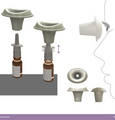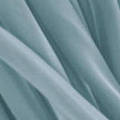Plant-Based Cellulose Super Material is as Stiff as Steel
by: Inhabitat , 2013-12-18 22:56:55 UTC

Recent scientific findings that unveil the remarkable structural performance of plants could completely change what we think of as “green architecture.” Researchers at Purdue University who conducted an experiment on cellulose nanocrystals concluded that the material, which is the structural basis of plant life, has the stiffness of steel.


Read the rest of Plant-Based Cellulose Super Material is as Stiff as Steel
Permalink | Add to del.icio.us | digg
Post tags: biomaterials, biomimesis, biomimetic architecture, cellulose, cellulose nanocrystals, green architecture, green building materials, green buildings, green technology, Purdue University materials, quantum mechanics, renewable materials, scientific discoveries, super-materials





 Upcycle House by Lendager Arkitekter
Upcycle House by Lendager Arkitekter
by: mocoloco, 2013-12-18 18:49:08 UTC

 Make Your Own Furniture With Design Components by Michael Bernard
Make Your Own Furniture With Design Components by Michael Bernard
by: design milk, 2013-12-18 17:00:13 UTC

Berlin-based designer Michael Bernard has a lot on his plate and we like every single thing. His furnishings seem to be centered around two basic principles: simple and sustainable. He creates objects that interact with things we either build ourselves or already have in order to make an entirely new piece that feels much more personal.

The Leviathan table legs, made from lightweight wire-tubing, gain their stability once connected to the user’s tabletop and allow for simple construction and dismantling.


The Ad Hoc Lamp offers the user the possibility of an individual design. The lamp’s head and base can be connected with any object that fits inside the conduits and then fastened with a locking screw.




The Nooks Shelf System consists of nothing but brackets, in practically endless combinations of color, material and board thickness (thanks to on demand 3D printing), allowing the tool-free assembly of any selection of wood into a custom storage unit.



The legs of this Trestle Bed take the advantage of a standard bed frames and can easily attach without tools. The space-saving, stackable feet can be easily assembled and dismantled.







 The U.K.'s First "Social Supermarket" Fights Food Poverty
The U.K.'s First "Social Supermarket" Fights Food Poverty
by: Co.Exist, 2013-12-18 14:11:00 UTC
The Community Shop is more than a discount supermarket--it's a hub that provides everything from debt advice to cooking classes.
For someone struggling to afford basic groceries, a discount supermarket can help, but it still doesn't solve the basic problem of food poverty. In the U.K., a new store is trying get a step closer to a real solution with the country's first "social supermarket."
Read Full Story

 Karuna House Becomes the World’s Greenest House
Karuna House Becomes the World’s Greenest House
by: Jetson Green, 2013-12-09 07:50:07 UTC

Karuna House, a single family residence which stands on the hilltops of Yamhill County, Oregon has received the Passive House (PHUIS+), Minergie-P-ECO and LEED for Homes Platinum certifications. It is the only house in the world to receive all these hallmark certifications of green building. The house was designed by Holst Architecture and built by the company Hammer & Hand.
So as to obtain the three certifications, and become a net zero energy structure, Karuna House was designed and built to have an advanced building enclosure. It also features an optimized solar design that works to drive energy loads to very low levels. The energy needed for the household is supplied via a solar photovoltaic array of less than 10 kilowatts.

The foundation of Karuna House was built by pouring concrete onto a thick layer of EPS (expanded polystyrene) geofoam. To stay within the LEED and Minergie-ECO requirements, the builders uses concrete made with a 30% fly ash mix and locally-sourced aggregate, which helped reduce the ecological footprint of using concrete, as well as diverted fly ash from landfills, and reduced the demand for the materials needed to make Portland cement.

Next the builders needed to create an airtight, watertight, vapor permeable, and super-insulated wall assembly. The interior walls of Karuna House are finished with lime plaster, which is 100% natural and VOC-free, and which was applied on 5/8” drywall. The stud wall was built solely from FSC certified wood. Cellulose insulation, which is comprised of 12 tons of recycled newspapers, was then blown into the cavities between studs, and gives the walls the insulation rating of R-21. The air-barrier was formed using a ½” layer of plywood sheathing covered with a continuous, vapor permeable liquid applied membrane.
Following this, they installed a 6”-thick exterior layer of foil faced polyiso foam (R-40), which raises the house’s insulation rating to almost R-60. There are also three layers of 2-inch foam nested into a superstructure of Z-joists that staggers each layer’s seams, while exterior seams were seated using vapor permeable tape. This is followed by a rain screen system made of FSC-certified cedar siding, which is held one inch off the polyiso foam by FSC 1×4 battens.

Much attention was also placed on the fenestration of Karuna House to ensure its air-tightness, which was achieved by installing triple-glazed windows, and using liquid applied flashing, among other techniques. Karuna house also boasts of a highly-efficient HVAC system, a part of which is also a low-temperature radiant system installed throughout the floors of the home, which works by harnessing the heat transfer power of water to balance temperatures between rooms. The builders also installed a Zehnder heat recovery ventilator, which captures 90% of the heat from the exhaust air and works virtually soundlessly.

Household hot water is supplied via a high-efficiency heat pump. To reach Passive House standards, the installed hot water supply pipes were carefully sized to minimize the amount of hot water left in the lines after each use. All hot water lines were also fully insulated from the mechanical room to the fixture. The builders also installed an on-demand hot water recirculation system, which does not run round the clock as most conventional systems do.
 Creative loom-inspired bookcase suspends books in mid-air
Creative loom-inspired bookcase suspends books in mid-air
by: TreeHugger Design, 2013-12-17 13:00:00 UTC

This is an unassumingly elegant solution to an age-old problem: how to get a mess of books to look more organized, but not boring.
How The World Would Look If We Could See All The Radiation From Our Cell Phones
by: Co.Exist, 2013-12-12 12:24:00 UTC
You can't see it, but our entire cellular network is constantly bathing us in radiation. Better hope it's really harmless.
If you're reading this, you're likely bathed in several channels of cell phone radiation at once. But while we can spot cell phone towers and antennae, the waves themselves remain invisible. Following up on a project to visualize what Wi-Fi might look like in cities, artist-researcher Nickolay Lamm has imagined what cell phone radiation would look like if emitted as waves of light.
Read Full Story






 Forget Organic: This Farmer Has 100 Types Of Fruit Trees In His Permaculture Orchard
Forget Organic: This Farmer Has 100 Types Of Fruit Trees In His Permaculture Orchard
by: Co.Exist, 2013-12-13 14:55:00 UTC
At Miracle Farms, one farmer is on a mission to show the world that permaculture--a food production system that models itself on the natural world--can work on a commercial scale.
What's the most environmentally friendly way to grow an apple? For most people, organic farming sounds like the ideal. But biologist and educator Stefan Sobkowiak thinks a better answer is permaculture, which models food production on natural systems so it's essentially self-sustaining. He's on a mission to prove that permaculture orchards can work at commercial scale.
Read Full Story






 EU resource efficiency improves but trend remains ‘volatile’
EU resource efficiency improves but trend remains ‘volatile’
by: Euractive, 2013-12-13 06:48:46 UTC
The European Union generates €1.60 of economic value for each kilogramme of material consumed, compared to €1.34 a decade ago, but progress towards resource efficiency remains “volatile”, according to the EU’s statistics office.
The data, released by Eurostat on Thursday (12 December), suggests that the European Union gradually ‘decoupled’ economic growth and its use of resources between the years 2000 and 2011.
The €0.26 gain in efficiency came because EU gross domestic product (GDP) grew faster than the average household’s consumption of materials.
“These divergent trends - GDP growing while DMC [domestic material consumption] falls - imply an absolute decoupling of economic growth from resource use in the EU between 2000 and 2011,” said the Eurostat report, ‘2013 monitoring report of the EU sustainable development strategy’.
Economic crisis reduces consumption
But the economic crisis may have had an impact on the figures, Eurostat said, as households began to cut down on waste and expenditure, whether they saw their income drop or not.
“Since 2007, EU resource use has dropped sharply, putting DMC below levels seen even ten years ago. However economic recovery indicates a trend reversal in 2011,” said the report.
Eurostat therefore defined resource efficiency as an area showing “volatile” progress, compared to other “sustainable development” indicators included in the report.
The resource efficiency part of the report only included materials which had entered the "formal" economy, such as food, cleaning products and fuel. Eurostat used data such as surveys, administrative sources and statistical estimations provided by EU countries.
The re-use, recycling or incineration of materials are ways to deliver increased economic value from each kg of material produced, the European Commission says.
Eurostat publishes the report every two years to monitor Europe’s progress towards its goals of sustainable development, defined as the improvement of the quality of life and well-being of each EU citizen.
Walter Radermacher, Eurostat’s chief statistician said the report, its fifth edition, was intended to contribute “on behalf of the European Union to the global debate on the future of sustainable development and the challenges lying ahead of us all - citizens, policy makers and statisticians”.
The other sustainable development indicators include socioeconomic development, public health, social inclusion and climate change and energy, among others.
Ruben Thier Creates Wonderful Recycled Furniture from Plastic Factory Waste
by: Inhabitat , 2013-12-13 19:30:31 UTC

Dutch designer Ruben Thier‘s clever Organic Factory furniture is made from plastic waste and excess material salvaged from factory floors. To make these reclaimed wonders he sneaks in between shifts and uses the factories’ extruders and machines to turn out durable seats, benches and tables. Thier’s irregular and organic creations make the most from waste and use industrial machinery in a new way.





Read the rest of Ruben Thier Creates Wonderful Recycled Furniture from Plastic Factory Waste
Permalink | Add to del.icio.us | digg
Post tags: crowfunding, Design Academy of Eindhoven, dutch design, Eindhoven, factory waste, green products, Organic Factory, Recycled Materials, Recycled Plastic, Ruben Thier












Comments by our Users
Be the first to write a comment for this item.